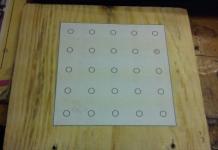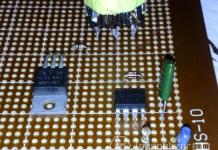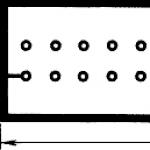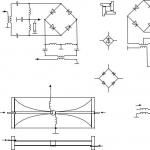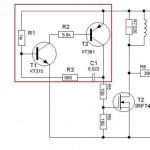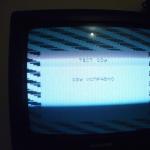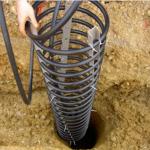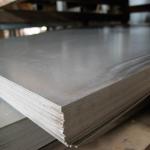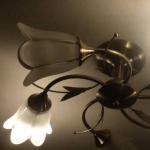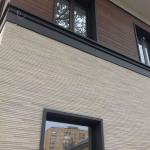Do-it-yourself Pirate metal detector assembly description, 3 types of suitable boards, answers to popular questions about proper soldering. 3 nuances about soldering boards + TEST for somo verification.
TEST:
small test- What circuits are most suitable for use on a metal detector?
a) Transistor or NE555.
b) KR 1006 VI1, NE555 or Am2504.
- What is the preferred scheme to install on a Pirate and why?
a) Transistor - it will increase the range of the device.
b) NE555 as it will provide better stability in operation.
- What power source is connected to the board for the operation of the metal detector?
a) One Krona battery.
b) Four Kron batteries connected in parallel.
c) One battery.
- When assembling an apparatus on a transistor, what does the resistor R1 mean?
a) Generation frequency.
b) Pulse duration.
Answers:
- a) To assemble a metal detector with your own hands, it is advisable to use a transistor board or NE555.
- b) It is preferable to use the NE555 board for installation on the detector. Thus, the operation of the equipment is significantly stabilized.
- b), c) For the normal functioning of the metal detector, a power source is used in the form of four Kron batteries connected to each other or one battery. Both sources are suitable, but for simplicity they put a battery and do not waste time connecting the batteries.
- a) R1 on the transistor means the generation frequency. The pulse length is denoted as R2.
Definition: The Pirate (MP) metal detector is a pulse-type device with a scheme that is understandable for self-assembly. The metal detector consists of a small number of elements and a coil.
If you use a coil of 280 mm, then the coins are at a distance of up to 20 cm, and large metal - up to 1.5 meters.
The metal detector got its name from the manufacturers of the circuit - PI, which means impulse action. RAT stands for Radio Cattle, the manufacturer's website.
Many searchers are interested in how to set up a Pirate Metal Detector for coins. A self-assembled apparatus does not distinguish between metals and coins at a distance, but with the help of it they learn to look for metal parts. For beginners, this is a good experience. Also a big advantage of the Pirate model is the ease of assembly and the fact that all components are easy to find. In addition, parts are inexpensive and are sold at any radio store.
Also, it is not necessary to install various programmable elements on the Pirate, and this will greatly simplify the life of radio amateurs. Even if a person is extremely superficially familiar with the process of assembling electrical equipment, it will not be difficult for him to assemble a metal detector with his own hands.
How to make a Pirate Metal Detector with your own hands? We pass the test and follow the instructions.
Pirat Metal Detector Parts List for NE555 Circuit
This Pirate Metal Detector radio kit is suitable for NE555 circuit.
Radio components are very easy to find in old electronics. And if not enough - there are many specialized stores.
Also for assembly you need to find additional parts and tools:
- The wire that will be wound on the coil. Suitable PEV 0.5.
- Chip NE555. It will install a node for transmission.
- Plastic material for making the case.
- Tape or duct tape.
- Small soldering iron.
Having found everything you need, just assemble the Pirate Metal Detector with your own hands at home.
2 detailed schemes for assembling the MP with your own hands
To assemble the Pirate metal detector, 2 schemes are used. For the first option, you need to find the NE555 chip - it was used in Soviet times and it was an analogue of the KR 1006 VI1.
NE555But if it is not possible to find NE, then a transistor circuit is used. It is advisable to still try to get NE555, since the stability of the vehicle will increase significantly.

If there is a desire to assemble an apparatus on a transistor, then you will also have to choose the duration and frequency. Such transistors have a variety of parameters. You need to use an oscilloscope. Resistor R1 - generation frequency. R2 is the pulse range.
2 printed circuit boards of the Pirate metal detector: sorting it out on the shelves


After soldering the board, you need to connect the power.
If you wish, you can use Crowns connected to each other. 4 pieces are enough for normal operation. But it is easier to connect one battery (9V).
In the case of using a battery, it must be borne in mind that one will not be enough, since the voltage will often drop, and this will cause a tuning failure.
If you examine the soldered finished board, then you need to look at the capacitors located on the left side. They are film-like, having great thermal stability. If you install them, it will positively affect the stability of the device.
More board options:
- PCB for MP on tl072.
- PCB on MP sprint layout.
- MP and microchip with gong.
- K157ud2. Sometimes people are interested in how to replace k157ud2 in MP. The KR1434UD1A board will do.
Board example
3 nuances of making a basket coil for MP with your own hands
It is not difficult to make a coil for MP with your own hands. The high accuracy of the coil assembly does not play a big role if it is used on impulse equipment. Not everyone knows how to wind a coil on an MP - it is simply wound on a two-hundred-millimeter mandrel or a little less. It is necessary to use 25 turns of enamel wire with a diameter of 0.5 mm.
- The coils will need to be processed with electrical tape.
- To increase the depth of the search for metals, a 270 mm coil is wound - 22 turns with the same wire.
- To calculate the coil, it is advisable to study the parameter table for different sizes. It is better to use a wire having a diameter of 0.5-0.6 mm. But if they could not be found, then 0.4 mm will do. The table shows the sensor diameters, number of turns, section diameter/wiring, inductance and resistance.

In order for the Pirate Metal Detector to work without interruptions, we fix the coil in a housing that does not contain any metal. In the image, the author of the work used a polypropylene cabin. This is a very good option without the use of metal inside. In this matter, the masters are given complete freedom of creativity - the main thing is that there is no metal.


Any body made of plastic material is used. Also, some people, to save time, wrap the product with electrical tape or tape. But this option does not look too aesthetically pleasing, and therefore it is still preferable to take a plastic tube as a basis - the choice is very wide and it will not be difficult to find the right one in the nearest plumbing store.

When making a plastic frame, we completely exclude impacts on the ground and grass at the site of the search for metal parts. The housing for the MP coil can be found on the net. Many aesthetes order products used on factory units and put them on their homemade products - thus achieving the aesthetic beauty of the product.

When assembling the coils, the use of metal should be avoided - it will interfere with the work on the search and it will not work to achieve its goal. This will have an extremely negative effect on the equipment. The conclusions from the coil must be soldered to a wire with several cores. It should have a cross-sectional diameter of 0.5 mm or a little more. Ideally, these should be several wires twisted together.

Homemade coil for MP is ready. Assembling a Pirate Metal Detector with your own hands is not as difficult as it might seem. And do not forget that, first of all, a metal detector is made for a specific purpose - metal search. And therefore, choosing a certain special design of the coil is superfluous. Only aesthetes and perfectionists should think about this. A coil wrapped with tape will give the same result as a part in a factory case.
Do-it-yourself metal detector "Pirate"
2 nuances about setting up and working with equipment
If the metal detector is assembled without errors, then there is practically no need to adjust it. Many are wondering how to increase the sensitivity of the Pirate Metal Detector. This can be achieved when small clicks begin to sound in the column. When it happens at the extreme points of the resistor, then the value of R12 is changed to the middle position. This is the only way to increase the sensitivity of the MP.
The oscilloscope controls: the frequency of the generator, the duration of the pulse. The pulse is 130-150 µs, and the ideal frequency is 120-150 Hz.
Working with a metal detector
Turn on. It will take half a minute to stabilize, after which the resistor R13 must be adjusted. After all the manipulations, we begin the search for metal.
How to avoid 4 mistakes
The Pirate metal detector is a simple device, and therefore it cannot have many malfunctions and they are quickly eliminated.
- When overheating or incorrect operation of the device occurs, you must immediately make sure that the ratings of all parts and assembly are correct.
- There are situations when the sound comes from the device, but it does not react to metals. The reason is T1, or diode D1. To fix the problem, the parts will have to be replaced with serviceable ones.
- The IRF740 is heating up. It is necessary to inspect the resistor R6. If it has the correct value, then lower it. For example, when it was 150th, then we set it to 100th. To better solve the problem, we use a variable resistor with a value of 200 ohms. Next, you should choose such a resistance so that the IRF740 stops heating up. After the necessary selection of resistance, we make sealing.
- T3 heats up, or burned out. Such a nuisance happens due to the fact that the master chose the wrong speaker. The resistance of a good speaker should be 8 ohms, the power should be 0.5 w.
The use of such tips in most cases helps to cope with all problems.
It is also important to know 3 nuances about soldering boards
To solder wires and boards, you need to know about several important nuances of work:
- Before starting the operation, it is imperative to choose a suitable soldering iron. The range of equipment for soldering boards is 15-30 watts. Above can not be used, otherwise the board will burn. An acoustic unit is ideal for work because of its small size and low degree of heating.
- To properly solder the board, it must be very well cleaned. This is how a strong connection is achieved. A soapy solution is prepared for processing, and after that the entire surface is wiped with a napkin. The metal after processing is qualitatively wiped from soap. Sometimes dense deposits are noticeable on the boards - they are removed with a special compound sold in an electrician's store. The area must be very well cleaned until a shine appears.
- Contacts on the board must be correctly positioned. First, small resistors are connected, and then we move on to large parts.
TOP 3 soldering irons for circuit boards
For high-quality processing of the board, you should use a soldering machine. The best manufacturers:
- Ersa is a German company. Fingers are expensive and need to be purchased for professional use.
- Chinese devices Quick are not inferior in quality, but the prices are much lower.
- Budget option Luckey. Ideal for beginners.
Answers to 5 frequently asked questions about board soldering
- How long do you need to keep the soldering iron for a secure fit?- 3-4 seconds is enough.
- Do you need to add a lot of solder?- The main thing is to completely cover the contact with them. If a drop does this, then this amount is enough.
- What color should the solder be - shiny or matte?- Closer to the first option.
- Need to use protective equipment?- Be sure to wear goggles so that the hot part does not get into the eye.
- What temperature can the chip withstand?- No more than 230 degrees.
It is easy to assemble all the parts for the Pirate Metal Detector with your own hands if you follow the instructions. Reviews and characteristics on the MP are mostly positive.
If there are still ambiguities on the manufacture of the Pirate Metal Detector with your own hands, then a detailed video instruction on the Internet will answer the remaining questions.
Homemade MP, made by hand, is perfect for a beginner.
Recently, such an activity as searching for various old coins, household items, and simply metal trinkets in the ground with the help of a metal detector is gaining great popularity. In fact, what could be better than walking in the morning through the field, inhaling the smells of nature, enjoying the views. And if at the same time it is possible to find some worthwhile find in the ground, then it’s a fairy tale in general. Some people do this on purpose, combing the fields all day looking for valuable coins or other valuables. They have expensive factory-made metal detectors at their disposal, which not everyone can afford to buy. However, it is quite possible to assemble a full-fledged metal detector by yourself.
This article will focus on the creation of the most popular, sought-after, time-tested, reliable impulse metal detector called "Pirate". It allows you to find coins in the ground at a depth of 15-20 cm and large objects at a distance of up to 1.5 m. The scheme of the metal detector is presented below.
Scheme metal detector "Pirate"

The whole circuit can be conditionally divided into two parts - the transmitter and the receiver. The NE555 chip generates rectangular pulses, which are fed to the coil through a powerful field-effect transistor. When the coil interacts with the metal located next to it, complex physical phenomena occur, due to which the receiving part has the ability to “see” whether there is metal in the coil area or not. The receiver chip in the original Pirate circuit is the Soviet K157UD2, which is now becoming quite difficult to get. However, instead of it, you can use the modern TL072, while the parameters of the metal detector will remain exactly the same. The printed circuit board proposed in this article is designed specifically for installing the TL072 chip (they have different pinouts).
Capacitors C1 and C2 are responsible for forming the frequency of rectangular pulses, their capacitance must be stable, so it is advisable to use film ones. Resistors R2 and R3 are responsible for the duration and frequency of the rectangular pulses that the microcircuit generates. From its output, they enter the transistor T1, are inverted and fed to the gate of the field-effect transistor. Here you can use any sufficiently powerful field-effect transistor with a drain-source voltage of at least 200 volts. For example, IRF630, IRF740. Diodes D1 and D2 are any low-power ones, for example, KD521 or 1N4148. Between pins 1 and 6 of the microcircuit, a variable resistor with a nominal value of 100 kOhm is turned on, with which the sensitivity is set. It is most convenient to use two potentiometers, 100 kΩ for coarse adjustment and 1-10 kΩ for fine adjustment. You can connect them as follows:

The speaker in the circuit is connected in series with a 10-47 ohm resistor. The lower its resistance, the louder the sound will be and the greater the consumption of the metal detector. The T3 transistor can be replaced with any other low-power NPN transistor, for example, with the domestic KT3102. You can use any speaker, the first one that comes across. So, let's move from words to deeds.
Assembling a metal detector
List of required parts
Microcircuits:- NE555 - 1 pc.
- TL072 - 1 pc.
- BC547 - 1 pc.
- BC557 - 1 pc.
- 100 nF - 2 pcs.
- 1 nF - 1 pc.
- 10 uF - 2 pcs.
- 1 uF - 2 pcs.
- 220 uF - 1 pc.
- 100 kOhm - 1 pc.
- 1.6 kOhm - 1 pc.
- 1 kOhm - 1 pc.
- 10 Ohm - 2 pcs.
- 150 Ohm - 1 pc.
- 220 Ohm - 1 pc.
- 390 Ohm - 1 pc.
- 47 kOhm - 2 pcs.
- 62 kOhm - 1 pc.
- 2 MΩ - 1 pc.
- 120 kOhm - 1 pc.
- 470 kOhm - 1 pc.
- Speaker 1 - pcs.
- Diodes 1N4148 - 2 pcs.
- DIP8 sockets – 2 pcs.
- Potentiometer 100 kOhm - 1 pc.
- Potentiometer 10 kOhm - 1 pc.
Printed circuit board
The printed circuit board is made using the LUT method, it is not necessary to mirror it before printing.(downloads: 1646)

On the board, first of all, you need to solder the resistors, diodes, then everything else. It is desirable to install microcircuits in sockets. The wires for connecting the coil, speaker, potentiometer and coil can be soldered directly to the board, but it is more convenient to use screw terminals, then you can connect and disconnect wires without using a soldering iron.




Coil making
A few words about the search coil. The most optimal option is to wind 20-25 turns of copper wire with a cross section of 0.5 mm2 on a round frame with a diameter of about 20 cm. The sensitivity depends to a large extent on the number of turns, so you should first wind more turns, 30 pieces, and then, gradually reducing the number of turns , select a number at which the sensitivity will be maximum. The wires from the board from the coil should not be long, preferably copper and with a cross section not less than the cross section of the coil wire.

Setting up the metal detector
After assembling the board, winding the coil, the device can be turned on. In the first 5-10 seconds after turning on, various noises and crackles will be heard from the speaker, this is normal. Then, when the operational amplifier enters its operating mode, you need to find with a potentiometer such a mode when individual clicks will be heard from the speaker. When a metal object is brought to the coil, the frequency of clicks will increase significantly, and if the metal is brought into the very center of the coil, the trust will turn into a continuous hum. If the sensitivity is not enough, and changing the number of turns of the coil does not help, you should try to choose the values of the resistors R7, R11, changing them up or down. The board must be washed from the flux, it often causes the metal detector to malfunction. Successful assembly!
The Pirate metal detector is the most popular pulse-type metal detector, as it consists of a small number of parts available, and countless assembly and setup instructions are written for it. But at the same time, the Pirat metal detector has good sensitivity, picking up signals deep underground.
The Pirate metal detector, unfortunately, does not distinguish between metals, but the ease of manufacture and high sensitivity smooth out this shortcoming. The detection depth of 28 cm with a coil is about 20 cm, and large metal objects are visible to him even at 1.5 meters.


List of necessary parts and tools for making a Pirate:
- Chip NE555 (for not having it, you can use the Soviet analogue KR1006VI1;
- Transistors IRF740, BC547, BC557, all in 1 piece;
- Diode 1N4148 - 2pcs;
- PEV wire with a diameter of 0.5 mm (for winding the coil);
- Soldering iron, solder, flux for soldering;
- Enclosure for PCB and batteries and plastic tube.
The entire list of parts with their characteristics in this plate:
Designation | Detail (type/power) | Rating/Name/Voltage
- R1 resistor 1 kΩ
- R2 resistor 1.6 kΩ
- R3 resistor 100 kΩ
- R4 470 ohm resistor
- R5 100 ohm resistor
- R6 150 ohm resistor
- R7 resistor (1W) 220 ohm
- R8 resistor (0.5 W) 390 ohm
- R9 resistor 47 kΩ
- R10 resistor 62 kΩ
- R11 resistor 2 MΩ
- R12 variable resistor 100 kOhm
- R13 variable resistor 10 kOhm
- R14 resistor 62 kΩ
- R15 resistor 120 kΩ
- R16 470 kΩ resistor
- R17 10 ohm resistor
- R18 resistor 10 kΩ
- DA1 chip NE555
- DA2 chip K157UD2
- C1 capacitor (film) 100 nF
- C2 capacitor (film) 100 nF
- C3 capacitor (electrolyte) 1uF/16V
- C4 capacitor (electrolyte) 10uF/16V
- C5 capacitor (ceramic) 1 nF
- C6 capacitor (electrolyte) 10uF/16V
- C7 capacitor (electrolyte) 1uF/16V
- C8 capacitor (electrolyte) 2200uF/16V
- T1 transistor (bipolar P-N-P) BC557
- T2 transistor (bipolar N-P-N) BC547
- T3 transistor (MOSFET N-channel) IRF740
- D1 diode (Schottky) 1N4148
- D2 diode (Schottky) 1N4148
- BA1 speaker 8 ohm
- L1 search coil 2 ohm
- PW1 power supply 9-12 Volts

Step-by-step instructions for creating a Pirate metal detector with your own hands:
It is necessary to etch the printed circuit board, there are many variations of such boards, we will give the most popular ones that you can download in the archive at the end of the article.




Now you need to solder all the details to our board, all elements are installed as indicated in the diagram. As for the details, for stable operation at different times of the year, you need to select thermostable capacitors, such are film capacitors, in the photographs of the assembled boards you can see how they look.



Choosing a power source for the Pirate metal detector. This device can be powered by a voltage of 9-12 volts, preferably closer to 12, while it behaves more stably and is more sensitive. You can use several 3-4 krone batteries connected in parallel, or a 12 V battery for this. Even in China, there are now many DC-DC boost modules (for example, the XL6009 or Mt3608 module), thanks to which you can power the device from the 1st battery 18650 at 3.7 V or one krone battery by setting a trimmer at the output of the 12 volt step-up module.
Making a coil for a Pirate metal detector. This metal detector and other pulsers are not demanding on the accuracy of manufacturing the coil, on its size and number of turns, although there are some requirements for the winding wire itself, it must be from 0.5 to 0.6 mm in diameter (winding wire in varnish insulation) , you can and 0.4 but the sensitivity drops a little. The coil is wound on a plastic mandrel (it can be a hoop or a plastic cover with a recess) with a diameter of 19-20 cm - 25 turns, after which the turns of the coil must be wrapped with insulating tape or tape. To increase the depth of detection of metal objects, you can make a coil with a large diameter. To do this, we take a mandrel with a diameter of 26-27 cm and wind 21-22 turns on it.
To calculate the winding of other coil diameters for the Pirate metal detector, here is a table:


After we soldered everything and checked the performance, we need to proceed to creating a case, select a suitable case for the metal detector board with batteries, put a switch and 2 knobs of variable tuning resistors on the front panel.

We mount the coil on a rod of their hard plastic (or wood) so that it does not dangle and does not bend under its own weight, since when searching, you will need to drive it over the ground to the right and left, scanning the search site. The conclusions from the coil must be soldered to a stranded wire, with a cross-sectional diameter of 0.5 - 0.75 mm. Ideally, these are two separate wires twisted together. The coil must be attached to the rod with non-metallic elements, otherwise the metal detector will constantly work.

The case can be completely different, for example, small pinpointers and compact underwater metal detectors are now made from Pirat from plastic pipes with a diameter of 32 mm. And the coil is filled with epoxy.
Working with a metal detector Pirate. A properly assembled metal detector with serviceable radio components practically does not need to be adjusted. After turning on the Pirate, it needs 10-15 seconds to stabilize, and then by turning the sensitivity adjustment knob of the variable resistor R13 we achieve rare clicks in the speaker, this will be the maximum sensitivity. If such a state appears only in the extreme positions of the resistor R13, then it will be necessary to more accurately select the value of the resistor R12, so that rare clicks appear somewhere in the middle position of the resistor R13. If you have an oscilloscope, you can check the correctness of the pulse at the gate of the transistor T2, the normal pulse indicators are: duration 130-150 μs and frequency 120-150 Hz.
The dream of finding a treasure is increasingly being replaced in our time by a more realistic program for searching for precious metals in a natural or artificial environment.
In modern conditions it is very important to find and extract valuable materials, turned out to be among the waste, or in another uncontrolled environment.
Hardware is an important component of such a search technology.
The search and extraction of gold and valuable metals from waste, garbage, in a natural setting is part of the recycling strategy, the technology for the efficient processing of used materials, including.
Searching for them in the ground or in a mass of industrial and other wastes not only requires the use of equipment, but also stimulates its improvement. Are being created devices of different levels and specializations. There is an interest in such equipment among amateurs and enthusiasts in the search for valuable metals.
 A metal detector is the most important tool for manually searching for metals in a chaotic natural or artificial environment.
A metal detector is the most important tool for manually searching for metals in a chaotic natural or artificial environment.
With the help of such a device, you can search not only, but also, silver, and other precious metals.
Device principle any metal detector based on electromagnetic effects.
Here is how a typical metal detecting technology works:
- device creates an electromagnetic field.
- Metal an object, secretly located in a foreign environment, affects such a field when falls within his sphere of influence..
- device captures the effect of the object on the electromagnetic field and signals it.
Most metal detector models work on this principle.
Technical differences of such equipment allow obtaining more complete information about the fact of detection of a metal object, for example:
- estimate the mass of the find;
- get data about the shape, size and configuration of the object;
- specify the location, including depth.
There is a lot of information on the Web about metal detectors of varying complexity and design. There you can brush up on the electromagnetic field theory, studied at school.
The simplest, primitive metal detectors (usually these are self-made designs for searching for gold, silver and other metals by amateur enthusiasts) assembled from finished devices and products working with the use of electromagnetic effects.
Many are familiar with the primitive, but quite workable metal detector circuit, in which the electromagnetic field creates a pulsed element of a conventional calculator.
 reaction created field on the detected metal objects picks up the simplest household radio. The signal about such a find is audible, quite distinct and understandable.
reaction created field on the detected metal objects picks up the simplest household radio. The signal about such a find is audible, quite distinct and understandable.
More complex amateur and professional metal detecting devices preserve the logical basis of technology in the form of three components:
- electromagnetic field generator;
- a sensor for changes in this field;
- equipment for evaluating detected anomalies, signaling this.
Devices of different levels of complexity and functional potential can be conditionally divided into groups. Classification based on professionalism and specialization of users - one of the generally recognized:
- amateur equipment assembled by oneself and used as a hobby tool or by beginners in the search for metals;
- semi-professional equipment necessary for enthusiastic amateurs and fanatics;
- professional metal detectors for permanent workers in this field;
- special devices for metal searchers in difficult conditions - at depth, under water, with the release of precious metals.
The distribution of search equipment is such that many devices of this type can be purchased at garden and country equipment stores.
An apparatus for searching and detecting metal is needed not only in the recycling business, in the search for artifacts and treasures. Numerous security systems, all well-known frames - one of the versions of the technology metal search. The settings of these frames are focused on the search for weapons and similar dangerous items.
Coil
Very important node metal search equipment - coil or frame. This is most often a winding of a special configuration, the task of which is to form an electromagnetic field and catch its reaction to the detection of a metal body foreign to the search environment.
In most designs the coil is placed on a long rod– a handle to move it near the search area.
For amateur manufacturing of coils, frames of the most popular types are sold. The easiest way to make such a purchase is in an online store.
 Many lovers make coil frames yourself. This is done for reasons of cost savings or in the hope of obtaining a higher quality instrument of the author's design.
Many lovers make coil frames yourself. This is done for reasons of cost savings or in the hope of obtaining a higher quality instrument of the author's design.
For this, improvised means are used.- plastic products, plywood and even filling the assembled winding with mounting construction foam.
The search operator or treasure hunter seeks to find the most effective technique for working with a metal detector, choosing the right electronics operating modes and the correct methods of manipulating the coil.
Electronic circuit
The logical element of the metal detector is an electronic circuit. She performs many functions:
- The first task of this component is in creating an electromagnetic signal of the desired format, which is converted into a field by means of a coil.
- The second task of the electronic circuit is analysis of field changes caught by the frame, their processing.
- The third task is giving an informing signal to the operator- sound, light, readings of indicators and instruments.
It is best if a person who wants to assemble an electronic circuit independently has knowledge of amateur radio or electronic technology. Such a master can not only assemble the desired circuit, but also change and improve the design.
Many electronic devices are quite simple, even a beginner can assemble them. The resulting device will be operational without configuration if the assembler exactly followed the recommendations of the developer of such a scheme.
How to make "Pirate" yourself?
 One of the most popular models of metal detectors designed for DIY amateur production is the Pirate.
One of the most popular models of metal detectors designed for DIY amateur production is the Pirate.
Abbreviated for his device and developer's website, this name wittily captures the romance of finding precious metals.
Here main advantages of this model:
- simplicity of device and assembly;
- low cost of parts and materials;
- sufficient operating parameters;
- recognized convenience for beginners.
The electronic circuit of this model does not require programming. In "Pirate" parts available to everyone are used, correctly assembled circuit is fully functional.
Design and principle of operation
The design scheme and layout of the "Pirate" metal detector is traditional for equipment of this kind. It is a rod, at the lower end of which is installed coil, and at the top - electronic unit with battery.
The location of the electronic unit should leave room for convenient holding of the rod by hand.
Some masters prefer that the sound signal of the device is given not by a speaker, but by headphones. In this case, the headphone cable leaves the electronic unit.
The technology of the device is pulsed. This makes it possible to provide very good sensitivity indicators for this class of equipment. Below is a diagram of an electronic unit on microcircuits. 
A similar circuit can be assembled using transistors instead of microcircuits. This version may require additional settings available only to experienced radio masters. That is why the transistor circuit is used less frequently.
Materials, parts and blanks
In addition to the details and precisely indicated on the circuit diagram of the electronic unit, for assembly metal detector for gold and other metals you need to prepare some materials and blanks:
- a ready-made board for assembling an electronic circuit or foil material for its self-production;
- power source in the form of any combination of accumulators or batteries with a total voltage of 12V;
- enamel wire with a cross section of 0.5 - 0.6 mm for the manufacture of a coil;
- stranded copper wire for connections with a cross section of at least 0.75 sq. mm;
- housing for the electronic unit - a plastic container of a suitable size;
- Sufficiently strong plastic pipe for the rod;
- frame for winding the coil;
- consumables - solder, heat-shrinkable cambric, electrical tape, screws and self-tapping screws, adhesives and sealants.
A printed circuit board for assembling an electronic circuit is best done according to the model of developments presented on the Internet.
Below is one of these samples suitable for the assembly of electronics on microcircuits.

Fans of home-made electronics are engaged in the manufacture of the board, and even then not all. Most people who want to create a metal detector on their own prefer to buy such a part.
For coil assembly frame or frame required containing no metallic elements. An amateur craftsman can make such a frame from plywood, plastic, or pick up a similar one in terms of parameters from finished plastic products, for example, dishes. The frame can be purchased ready-made or made independently.
Recommended coil parameters- 25 turns of enamel wire with a diameter of 0.5 mm along a mandrel with a diameter of 190-200 mm. Increasing the diameter by 30% will lead to an increase in the sensitivity of the device, provided that the number of turns is reduced to 20-21.
A plastic frame for a coil is one of the most common metal detector parts on sale.
The coil manipulation technology is such that this very fragile assembly can suffer from impacts on uneven ground, stones, and sharp objects. To avoid this the coil on the frame is covered from below with a plastic plate. Such a dish not only protects the coil, but also provides a sliding mode on tall grass. The search becomes more intense.
Assembly order and design
 For a successful metal detector assembly it is best to follow this procedure:
For a successful metal detector assembly it is best to follow this procedure:
- PCB manufacturing and electronic circuit assembly;
- selection of a suitable plastic container for it and completion of the assembly of the electronic unit;
- coil manufacturing;
- manufacturing a conveniently shaped rod and attaching an electronic unit and coil to it, making connections to the electronic circuit.
Although the order of assembly is not fundamental. For those who manufacture an apparatus for continuous long-term work in the field of non-ferrous metal search and subsequent recycling (recycling for reuse), ease of use is an important factor.
In this case, the study of the shape of the rod and the layout of the main elements of the apparatus becomes a key factor. Thus, a serious design phase appears in the creation of the device.
The best way to do this step is to use life size simulation. Such modeling can be done using wooden parts of a suitable shape, for example:
- shank for a shovel;
- plywood pieces of the desired shape;
- scraps from;
- temporary fasteners from pieces of wire, nails and ropes.
After making sure that the assembled model of the device will be functional and convenient enough, you can proceed to the final assembly. Finished apparatus, usually, does not require configuration, it is completely ready to work. You can start searching for metal by choosing the desired level of sensitivity and the correct tactics for manipulating the coil.
 Assemblers who need to assemble their apparatus as quickly as possible, can use ready-made kits.
Assemblers who need to assemble their apparatus as quickly as possible, can use ready-made kits.
The purchase of such a kit allows you to greatly simplify the manufacture of "Pirate". There is one of the proposals.
Users of the Pirate metal detector, who have skills in amateur radio, modify the design of this device. That's just several directions such improvements:
- Manufacturing coils with unusual parameters- by size, from special materials, for example - twisted-pair cable.
- The device of additional functional systems, for example - indication of the degree of discharge of the battery.
- Manufacturing underwater models.
- Add-ons electronic circuit, to distinguish between metals(creating a discrimination function).
A simple, inexpensive and reliable metal detector "Pirate" works properly in a variety of conditions.
Homemade metal detector - pros and cons
Cheapness, base advantage self-manufacturing of any products is relevant for a metal detector. Here are some more dignity on a homemade device:
- the most relevant search technology for beginners;
- the possibility of creating a device of a completely individual shape, design and configuration;
- the pleasure of making an efficient, workable device on your own.
Like any device made by an amateur, a metal detector not without some shortcomings.
 Here are the features of the Pirate model that users note:
Here are the features of the Pirate model that users note:
- vigorous charge consumption batteries;
- no discrimination, that is, accurate sensitivity to ferrous, non-ferrous and precious metals;
- limited compared to expensive models sensitivity.
Despite the shortcomings, the Pirate model is very popular. This is due to the simplicity of home-made manufacturing and the high performance of an inexpensive device.
Recycling professionals believe that the discrimination capabilities of a metal detector are not of great importance. All found metals are so valuable that their processing is always justified. Orientation to the search for gold requires not only equipment, but also considerable experience, accompanying knowledge and of course Good luck.
Related videos
The video provides a detailed guide to the manufacture and assembly of the Pirate metal detector with your own hands:
Conclusion
When the metal detector is ready, you can start working. You need to be aware that not a single most advanced apparatus will allow you to find only golden hidden objects.
A metal detector will help you find valuable metal, and it is very likely that it will be gold. It is best if the future metal and gold prospector has a real understanding of the search technique.
Many features of the operation of finished equipment are very important for those who develop and assemble their own models. You need to have an idea about the technology of work in advance with such equipment - this is the basis of its high-quality design.
The effectiveness of the search for gold increases with experience. Here the most important elements such experience:
- the right choice of metal detector design and its high-quality do-it-yourself manufacturing;
- the ability to correctly select the search site;
- the ability to use the full potential of the metal detector;
- choosing the right search technology in different conditions;
- metal detector upgrade.
Properly assembled and debugged equipment will always help in the search for gold, and this valuable metal will definitely be found.
In contact with
The metal detector market is represented by a large number of models from different companies. The cost of individual copies can be several times higher than the price of basic versions. The deeper the device searches, the more expensive it is. Not every metal detector, for example, is able to find a small coin lying at a depth of only 5 cm. The presence of a metal recognizer and a display for adjusting the operation of the metal detector also increase the price of devices.
 The simplest model of a metal detector - a pirate - can be assembled by hand. The circuit is so simple that even a novice radio amateur can handle it. The name of the device comes from the abbreviation of the English word for impulse (PI) and the site on which the circuit was first posted for free access (RAT - radioskot.ru). A pirate is able to find coins at a depth of up to 20 cm. For larger objects, an indicator of 180 cm is also possible. The only problem is that this model cannot be used in soil contaminated with heterogeneous metal: there is no pirate metal detector scheme with metal discrimination.
The simplest model of a metal detector - a pirate - can be assembled by hand. The circuit is so simple that even a novice radio amateur can handle it. The name of the device comes from the abbreviation of the English word for impulse (PI) and the site on which the circuit was first posted for free access (RAT - radioskot.ru). A pirate is able to find coins at a depth of up to 20 cm. For larger objects, an indicator of 180 cm is also possible. The only problem is that this model cannot be used in soil contaminated with heterogeneous metal: there is no pirate metal detector scheme with metal discrimination.
Assembly materials and tools
Stock up on the following a set of radio components and materials:
- chip KR1006VI1 or imported NE 555 - the basis of the future assembly;
- transistor IRF 740;
- chip K157UD2, transistor VS547 - the basis for the receiving unit;
- wire PEV 0.5 - for the manufacture of the coil;
- NPN transistors;
- materials for the manufacture of the case.
Tools required for mounting a metal detector:
- soldering iron;
- insulating tape;
- drill 1 mm.
A diagram with a set of other parts can be downloaded below.
For the electronic circuit, you will also need a plastic box. For the manufacture of the rod to which the coil will be attached, it is necessary to purchase a piece of plastic pipe.
Step by step assembly of a metal detector
PCB manufacturing
 Let's start with the most difficult - electronics. According to the instructions, we will make a printed circuit board. There are several options for this part, depending on the radio elements involved. This is a board for the NE 555 chip, and a variant for transistors. We find a sketch on the network and print it on a sheet of paper. According to these dimensions, we cut out a piece of textolite. We impose a sketch on the workpiece and outline the locations of future holes. We drill the workpiece with a drill or drilling machine. Then we draw tracks using photoresist or LUT (laser-ironing technology).
Let's start with the most difficult - electronics. According to the instructions, we will make a printed circuit board. There are several options for this part, depending on the radio elements involved. This is a board for the NE 555 chip, and a variant for transistors. We find a sketch on the network and print it on a sheet of paper. According to these dimensions, we cut out a piece of textolite. We impose a sketch on the workpiece and outline the locations of future holes. We drill the workpiece with a drill or drilling machine. Then we draw tracks using photoresist or LUT (laser-ironing technology).
Another option is to paint them with a brush using nitrolac. Tracks must exactly repeat the scheme. At the last stage, we poison the board with hydrogen peroxide.
Mounting radio elements on the board
 Soldering the elements to the board, strictly adhering to the chosen scheme. Do not forget about the need for capacitors, which ensure the stable operation of the device, which is especially important in the spring and autumn seasons, when a sharp temperature drop is possible.
Soldering the elements to the board, strictly adhering to the chosen scheme. Do not forget about the need for capacitors, which ensure the stable operation of the device, which is especially important in the spring and autumn seasons, when a sharp temperature drop is possible.
In this assembly, film capacitors.
The metal detector needs a 9 - 12 volt power source. Note that the device is energy-consuming due to considerable power. Therefore, it is necessary to use 2 - 3 batteries in parallel or, much more preferably, a rechargeable battery.
Coil
Since the metal detector is pulsed, the accuracy when assembling the coil is not very important. The diameter of the frame is on average 190 - 200 mm. The number of turns of the coil is 25. The turns must be well insulated, so we wrap the part tightly with electrical tape. To increase the detection depth, it is necessary to increase the diameter of the frame (260 - 270 mm), and limit the number of coils (up to 22). The cross section of the used wire is 0.5 mm.
The next step is to mount the coil on a rigid base (it should not be made of metal). Look for a suitable rounded case that will protect this part of the metal detector during search work.
The conclusions from the coil must be soldered to a stranded wire (0.5 - 0.75 mm). It would be preferable to use two separate wires twisted together.
Machine setup
If the metal detector is built exactly according to the scheme, it will not require additional adjustment: it is at maximum sensitivity. For fine adjustment, it is necessary to twist the resistor R 13 so that distinct, infrequent clicks are heard. If such a result is possible only with extreme unscrewing of the resistor, then there is a need to change the value of the resistor R 12. The device is tuned with the middle position of the resistor.
If you have an oscilloscope, you need to measure the frequency at the gate of transistor T2. The pulse duration should be 130 - 150 µs, and the operating frequency - 120 - 150 Hz.
The turned on device must stabilize, for this it needs up to about 20 seconds. Then we carry out tuning with the help of a resistor and proceed to search work.

